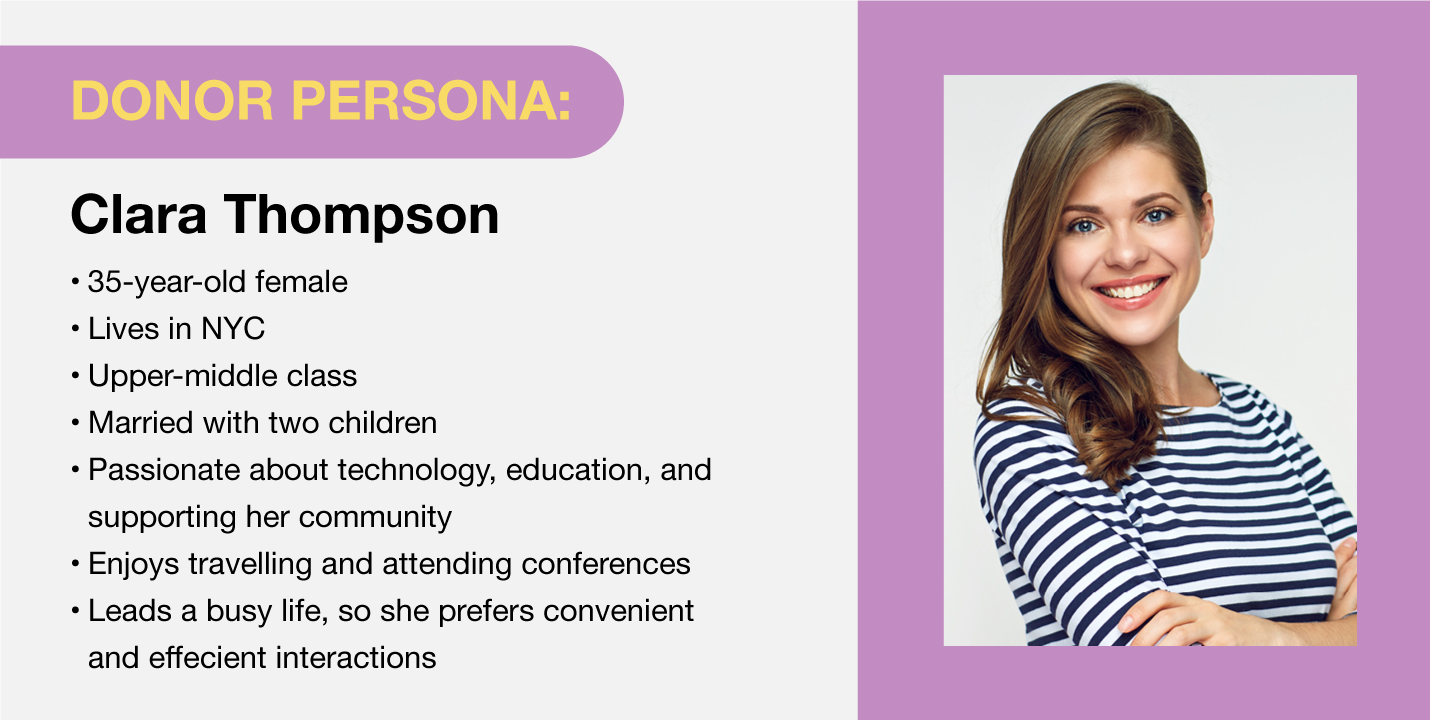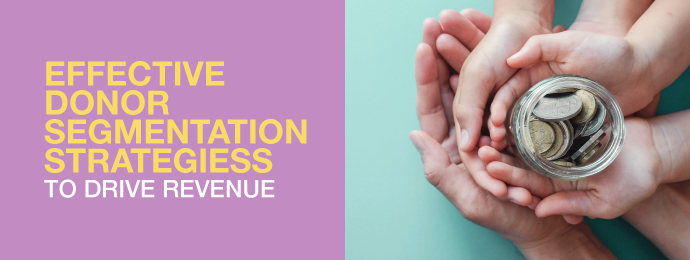Effective Donor Segmentation Strategies to Drive Revenue
Giving trends in the nonprofit sector are reflecting larger economic patterns. While the total revenue raised on GivingTuesday 2023 showed a small increase compared to 2022, the number of donors dropped by 10%. This and other similar trends could be cause for concern as your donors and development team alike contend with inflation and concerns about the future of the economy.
Although they aren’t favorable, these findings shouldn’t cause your organization to panic. Instead, focus on preparing for whatever the future holds by protecting and diversifying your revenue streams. One way to do this is by strengthening and personalizing your digital marketing efforts to appeal to your supporters’ unique giving motivations, boosting donations.
We’ll explore some of the top strategies you can use to inspire more support for your cause using segmentation—but first, let’s cover the basics of this process.
Donor Segmentation Basics
GivingDNA’s guide to donor segmentation defines the term as “a strategy that nonprofits use to separate a donor base into smaller subgroups based on shared traits and characteristics.” Segmenting donors helps you break down your full donor database into more manageable subgroups.
By uncovering distinct preferences and interests through external data insights, you can create segments based on those details that will help you develop more targeted, tailored communications. These groups, or segments, can be based on a variety of characteristics. Some of the most common categories include:
- Demographic data like age, gender, geographic location, income, and more.
- Psychographic data, which denotes information about the donors’ lifestyles, interests, hobbies, and values.
- Giving behavior like gift size, frequency, and recency.
- Communication preferences, such as preferred communication channels, frequency, and content formats.
- Engagement history, which reflects donors’ interactions with your communications, attendance at events, volunteer hours, and more.
These categories simply provide a starting point for your nonprofit. Depending on your unique needs, goals, and projects, you might experiment with more niche or specific segments.
4 Ways to Inspire Donations Using Donor Segmentation
Start with an RFM analysis.
An RFM analysis segments your donors based on the recency, frequency, and monetary value of their donations. This type of analysis can help your nonprofit identify the donors who are most likely to give. This way, you’ll gain a baseline understanding of your donor base and be able to allocate your marketing resources efficiently.
Here is a breakdown of each component of the RFM model:
- Recency: This refers to the amount of time that has passed since the supporter’s last donation. For example, perhaps they made an online gift two months ago after being inspired by your email marketing campaign.
- Frequency: This metric indicates the number of times a donor gives, usually within the last 36 months or so, representing how often they donate. Some may only give once a year or less, while members of your sustainer program donate each month.
- Monetary value: This tracks the amount of money a donor contributes to your cause. The best way to calculate this value is to find the donor’s median gift size over a certain time period, either five years or whenever you acquired the donor.
From here, score donors based on each of these components and then filter them into the appropriate segments. For example, let’s say you have a donor who gave three months ago, donates twice per year, and usually gives slightly more than your organization-wide average gift amount. This donor would have a high RFM score and should be placed in a segment for donors who are likely to donate in response to your marketing efforts.
While RFM analyses can be a great place to start, they only provide limited insight. These analyses can help you forecast how donors will respond to your appeals, but they are purely based on past behaviors. Additionally, the RFM model excludes many other important dimensions of donor behavior, particularly why they give.
Examine interests and psychographic characteristics.
Given the limitations of the RFM model, you’ll also need to learn why donors choose to support your cause. When you’ve uncovered their deeper motivations and personal connections to the issue, you can infer which stories, strategies, and appeals would be most effective in your marketing campaigns.
For example, let’s say a healthcare organization that researches multiple sclerosis (MS) and provides services to those battling the disease wants to dig deeper into why donors support the cause. Here is how this organization could use common psychographic traits to segment and appeal to donors:
- Lifestyle: There is a wide variety of lifestyle factors to consider, such as donors’ opinions, attitudes, social class, and personality. For example, are they adventurous risk-takers or conservative and family-oriented? The healthcare organization decides to segment donors based on their activity level and shares appeals that highlight the importance of mobility in quality of life to those who like to exercise and get outside.
- Hobbies and interests: This includes the things that donors like to spend doing in their free time, such as golfing, hiking, cooking, creative writing, or volunteering. The nonprofit creates a segment of donors who are passionate about nutrition and healthy, home-cooked meals. Then, it shares educational resources about nutrition, promotes tickets to a healthy cooking workshop, and invites supporters to participate in a recipe contest.
- Values and beliefs: Understanding donors’ values and belief systems will help you appeal to their sense of purpose. For instance, our example nonprofit could find that many of its donors believe strongly in equality and social justice. In this case, the organization could target the segment with appeals that highlight how its work and research work to address healthcare disparities and provide desperately needed services to those with MS.
For most people, their values, beliefs, and interests are deeply ingrained in who they are. So, you’ll be able to rely on insights from these segments for much longer than other traits that are subject to change (e.g., income), which can help you run profitable fundraising initiatives long into the future.
Track donor lifecycles.
Your donors pass through several distinct phases or “seasons” in their interactions with your nonprofit. Together, these phases make up the donor lifecycle, a process that encapsulates donors’ journey from discovering your nonprofit and donating for the first time to upgrading their support.
Understanding where donors fall in this lifecycle is crucial for properly welcoming new supporters, creating donor stewardship strategies, cultivating major donors, and motivating lapsed donors to re-engage. For example, let’s say you create segments for first-time donors, multi-year donors, and those who haven’t given in the last year. Here is how your communication strategies might differ for each segment:
- First-time donors: Start with a heartfelt thank-you, then aim to welcome these donors and educate them about your cause. Share a welcome email series or mail them a packet with materials they need to get to know your organization. Inform them of other ways to get involved to encourage them to engage more deeply. Carefully track data about this segment’s preferences and responses to messages to improve your recruitment efforts.
- Multi-year, active donors: During this phase, focus on stewarding your relationships with donors with the eventual goal of an upgrade. Keep your nonprofit on their minds by frequently communicating with them through their preferred channels. Make sure these messages also consider the other traits we’ve discussed. For example, invite them to fundraising events happening in their local area or share about initiatives that appeal to their special interests.
- Donors at risk of lapsing: These donors haven’t engaged with your nonprofit in a while—it’s up to you to determine why that is and inspire them to come back! Try sharing a survey asking them why they no longer support your organization to pinpoint weak points in your strategy. This segment likely won’t respond to demands for donations. Instead, start with smaller, more doable asks (e.g., reading a blog post about a specific beneficiary). Ask them to come back, whether they are attending an event, volunteering, or donating.
Knowing where your donors are in their journey not only boosts retention and revenue—it also shows them that you notice and care when they make that first gift or haven’t engaged in a while. They’ll feel valued for their individual efforts to support your work and seen as more than just a dollar sign.
Create donor personas.
Donor personas are profiles of fictional people who represent your target audience(s). Personas are designed to encapsulate the main traits and motivations of each donor segment, giving you a clear image of who those supporters are and what pushes them to take action.
For example, here’s a donor persona for a fictional donor named Clara Thompson:

Based on this persona, your team could extrapolate insights about the segment’s preferences. For example, someone like Clara who travels often, leads a busy life, and is passionate about technology would likely respond best to digital communications that make it quick and easy to donate. However, you may have another segment of retired seniors who would rather receive monthly updates via direct mail.
Referencing your entire donor database is important—this shows you organization-wide patterns you might otherwise miss. However, donor segmentation is an invaluable tool that will only become more important as hyper-personalized marketing becomes the norm. Applying these segmentation strategies to your marketing campaigns will give you the knowledge and ability to target donors with messages that feel made for them.




